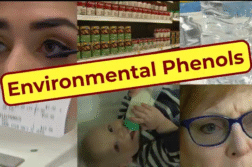COLUMBUS, Ohio (Ivanhoe Newswire) – According to the U.S. Centers for Disease Control and Prevention, more than 19.2 million adults struggle with seasonal allergies. It’s now the sixth leading cause of chronic illness in the U.S. If you struggle with seasonal allergies, your symptoms are likely much more acute this year and scientists say the environmental changes due to climate change may be to blame.
Busy college graduate student Kaitlin Baker loves to take study breaks but even a quick walk in the park used to cause complete misery.
“Just sneezing and sniffling and runny nose for about three hours,” she recalls.
No matter where she goes, she still does a quick pocket check. Does she have her tissues close by?
Baker says, “I do!”
Allergist and immunologist at the Ohio State Wexner Medical Center, Dr. Kara Wada, says she’s busier than ever.
“We’re seeing the effects of climate change in patients every day,” Dr. Wada emphasizes.
Scientists say the time between first thaw in the spring, when pollen emerges, and the fall freeze is much longer. That means plants have longer to give off more pollen.
Dr. Wada mentions, “We see a little bit of a one-two punch, so to speak.”
Dr. Wada says the environmental change affects long-time sufferers, and it’s leading to more people being diagnosed and seeking relief for the very first time.
“I like to take a three-way approach to the treatment of allergies,” Dr. Wada says.
First, avoidance; stay indoors if the pollen levels are high. If you do go outdoors, when you come back in, change your clothes and shower to remove pollen from your skin and hair. Next, medication; take antihistamines a few weeks before the season starts to halt the body’s allergy response. Finally, immunotherapy – a series of allergy shots.
Baker had immunotherapy to retrain her immune system. Now, she can enjoy the outdoors again.
“It’s beautiful. I love looking at the blooms and the flowers,” Baker says.
Contributors to this news report include: Cyndy McGrath, Producer; Kirk Manson, Videographer; Roque Correa, Editor.
To receive a free weekly e-mail on medical breakthroughs from Ivanhoe, sign up at: http://www.ivanhoe.com/ftk
Sources:
MEDICAL BREAKTHROUGHS
RESEARCH SUMMARY
TOPIC: SUPER SIZED ALLERGIES THANKS TO CLIMATE CHANGE?
REPORT: MB #5072
BACKGROUND: Allergy symptoms, which depend on the substance involved, can affect your airways, sinuses and nasal passages, skin, and digestive system. Allergic reactions can range from mild to severe. In some severe cases, allergies can trigger a life-threatening reaction known as anaphylaxis. Hay fever, also called allergic rhinitis, can cause sneezing, itching of the nose, eyes or roof of the mouth, runny, stuffy nose, watery, red, or swollen eyes. A food allergy can cause tingling in the mouth, swelling of the lips, tongue, face or throat, hives, anaphylaxis. An insect sting allergy can cause: a large area of swelling at the sting site, itching or hives all over the body, cough, chest tightness, wheezing or shortness of breath, anaphylaxis. A drug allergy can cause hives, itchy skin, rash, facial swelling, wheezing, anaphylaxis. For a severe allergic reaction, call 911 or your local emergency number or seek emergency medical help. If you carry an epinephrine auto-injector, give yourself a shot right away. Even if your symptoms improve after an epinephrine injection, you should go to the emergency department to make sure symptoms don’t return when the effects of the injection wear off.
(Source: https://www.mayoclinic.org/diseases-conditions/allergies/symptoms-causes/syc-20351497)
CAUSES AND RISKS: An allergy starts when your immune system mistakes a normally harmless substance for a dangerous invader. The immune system then produces antibodies that remain on the alert for that particular allergen. When you’re exposed to the allergen again, these antibodies can release a number of immune system chemicals, such as histamine, that cause allergy symptoms. Common allergy triggers include airborne allergens, such as pollen, animal dander, dust mites and mold. Certain foods, particularly peanuts, tree nuts, wheat, soy, fish, shellfish, eggs, and milk. Insect stings, such as from a bee or wasp. Medications, particularly penicillin or penicillin-based antibiotics. Latex or other substances you touch, which can cause allergic skin reactions. You might be more likely to develop an allergy if you have a family history of asthma or allergies, such as hay fever, hives, or eczema, are a child, or have asthma or another allergic condition. (Source: https://www.mayoclinic.org/diseases-conditions/allergies/symptoms-causes/syc-20351497)
CLIMATE CHANGE AND ALLERGIES: Climate change is an environmental issue. It is also a serious threat to our public health. The government has a plan to address climate change and its health threat. Rising temperatures caused by climate change led to longer allergy seasons and worsen air quality. Long allergy seasons can cause more allergies and asthma attacks. Between 1995 and 2011, warmer temperatures in the U.S. have caused the pollen season to be 11 to 27 days longer. These warmer temperatures create more pollen in the air, stronger airborne allergens and more allergy symptoms. (Source: https://www.aafa.org/extreme-allergies-and-climate-change/
FOR MORE INFORMATION ON THIS REPORT, PLEASE CONTACT:
Serena Smith
(614) 893-0370
If this story or any other Ivanhoe story has impacted your life or prompted you or someone you know to seek or change treatments, please let us know by contacting Marjorie Bekaert Thomas at mthomas@ivanhoe.com




